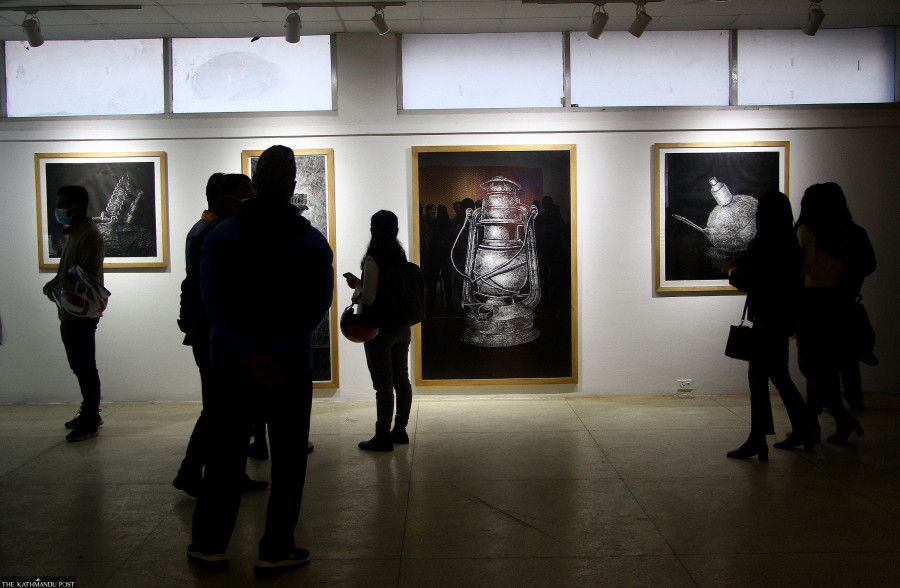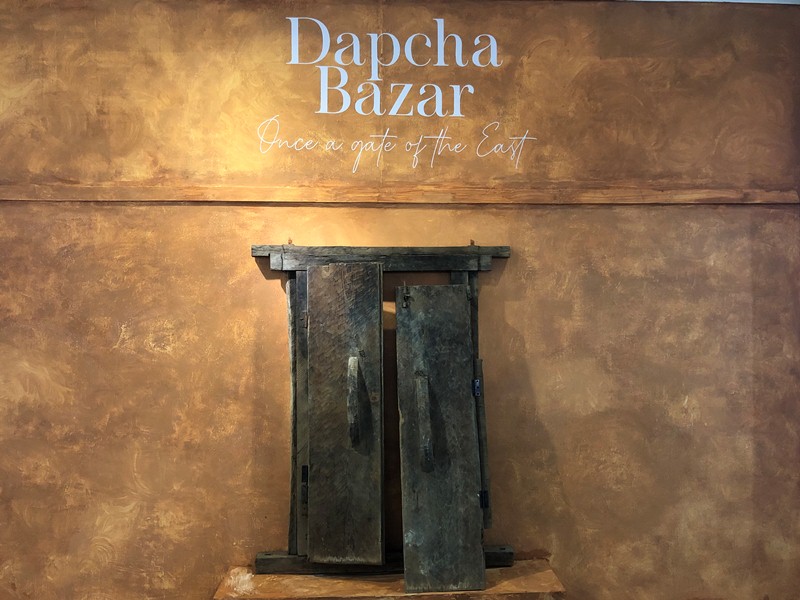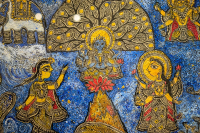Culture & Lifestyle
Un/confined within the confinement
Young artists in this year’s edition of Kathmandu University’s BFA exhibition, ‘Un/confined’ attempt to break boundaries with their art.
Pinki Sris Rana
Before entering the room adjacent to the staircase on the ground floor of Nepal Art Council, there’s a statement titled ‘Me in a space = A space in me’. Inside the room, there’s another room made with thin off-white covers. On the middle cover is an image of a large window grill (made by stitching cutouts of the off-white covers) while the three covers alongside each other are decked with fabric frames using the same technique. These frames enclose silhouettes of people and in some just void space.
The space is the concept of artist Kripa Tuladhar, who carefully makes a separate world inside a room to make it her space and lets viewers peek into it to transport them to the journey she experienced during coronavirus-induced lockdowns. Tuladhar, with the handsewn installation attempts to convey how the confinement made her look inwards and reflect on life.
Tuladhar’s work also seems to tell that as much as we determine the space we live in, the place that we create for ourselves also ends up shaping who we are or that every time we make an outwards pursuit in life, things are also taking space on the inside of who we are.
She compels viewers to see the complex relationship of the visible and the invisible space we create for ourselves by making her isolated world a subject to understand how we live within spaces and oscillate with our thoughts to make them our space.
Tuladhar’s installation is one of the many artworks in the exhibition ‘Un/confined’ organised by Kathmandu University, School of Arts, Department of Art and Design to present the art students’ final work for graduation. The show brings together the works of 26 graduating students (15 students from Graphic communication and 11 from Studio Art) under the generic theme or perhaps just a ‘title’ ‘Un/confined’.
It is the duality of the title ‘unconfined/ confined’ that keeps viewers hooked in interpreting the different meanings to the diverse artworks of the students.

For many viewers and people from the Nepali art community, the sight of the Nepal Art Council’s vibrant milieu of art ensures a hopeful future for the Nepali art scene. The variety of art from the students promises breakthroughs in art.
Each student artist makes the most of the space provided to them to take viewers into their journey of creating their work and thereby leaving a remnant of their thoughts and ideas with them.
One of the highlights of the show are the children's illustration books by artists that focus on teaching children the idea of using money, understanding good and bad touch to protect themselves, and gratitude for food.
Swornim Bajracharya focused on early finance literacy with her book ‘Money Jar’ for children from grades 1 to 5. Likewise, Richene Singh’s ‘Where does my Food come from?’ is another informative illustrative book that is information-heavy and has activities for children to indulge in. The book incorporates local foods (like churpi) to emphasise the representation of the Nepali food culture which are not represented in Western food books for children.
Many artworks in the show also highlight stories of secluded communities away from the hustling and bustling Kathmandu. They use different mediums of art to emphasise local stories and history.
Thinley Lama’s guide book on Tsum valley, located north of Gorkha, and Tsumpa community titled ‘Valley of Happiness’ explores the idea of preserving what has been left of the valley as young people like him grow more distant with their own history and traditions.
Alongside his work, Tsewang Lama highlights the handmade designs from Nubri Valley, neighbour to the Tsum Valley, to tell how the tradition of hand-weaving is disappearing fast and why it needs to be preserved. Lama also points that the Valley he is originally from still remains undocumented and overshadowed due to the one-dimensional perception of the Himalayan region. He explores the different prospects of the traditional graph-weaving technique used to make front aprons worn on their traditional attire by the women.

Saroj Shrestha, on the other hand, through his series ‘Dapcha Bazar’—that includes a book of photographs, sketches, and a traditional door from the region—takes the audiences back to the time of the Rana regime when the place, known as the east trade route, was the most vibrant trade pass. His works also tell the story of how young people of the place have now left the area for better opportunities while elderlies and the age-old feeble houses await proper development.
In another art series, Sujaan Shrestha’s photographic work ‘Dyah Myauju’ lets the viewers step into the lives of three individuals who have formerly lived as a ‘Kumari’, a living goddess. Her photographs were accompanied by audio recordings of the girls telling what their lives were like as the deity that people looked up to.
Sanju Thapa Magar from Tanahun in his painting series ‘Gaun ko Pratibimba’ portrays his memories of his village as a way of reminiscing his younger days. But what is striking in his statement is the use of the Nepali language that inadvertently points to his rejection of the universally adopted and often imposed English language.
The line-up works in the exhibition make it evident that these young artists, to bring their art to people, have turned to their own personal experience, culture, and history for inspiration. And that makes the show all the more interesting. But the repetitiveness of the idea through different students’ artworks in different mediums also brings us to reflect not just on the exhibition but the happenings all around, where all of us are inclined to sell ideas for acceptance and appreciation for the sake of what will work.
This analogy is not to say that these works are not substantial; the exhibition brings the best and the most unique stories forward. But the question of whether creativity is only confined to our personal experiences and stories remains, and by thinking so, it raises another question: Are we limiting ourselves in that confinement that ideas need to have origin and sound stories?
Nevertheless, ‘Un/confined’ is an intriguing exhibition that encourages viewers to think critically. Moreover, the artists’ choice of medium and storytelling through the topics they have picked demand viewers to think of the boundaries we have set for ourselves.
‘Un/confined’, BFA exhibition project 2021 will be held until Monday, 22 November, at Nepal Art Council, Baber Mahal.




 6.53°C Kathmandu
6.53°C Kathmandu















